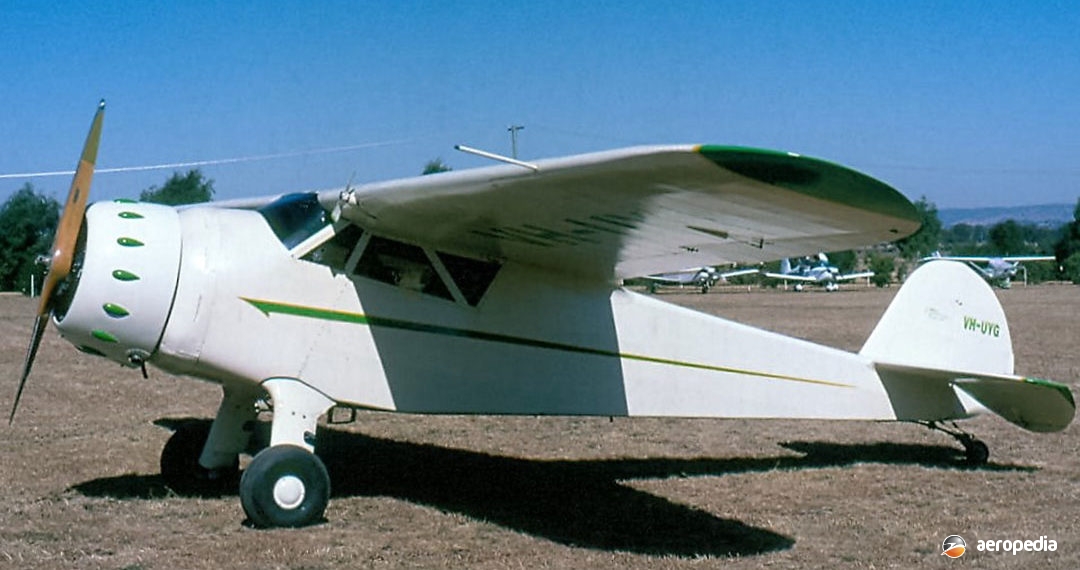Photograph:
Cessna C-34 VH-UYG (c/n 339) at Cowra, NSW in April 1995 (David C Eyre)
Country of origin:
United States of America
Description:
Light cabin touring monoplane
Power Plant:
One 108 kw (145 hp) Warner Super Scarab seven-cylinder air-cooled radial engine
Specifications:
- Wingspan: 10.33 m (33 ft 10 in)
- Length: 7.5 m (24 ft 7 in)
- Height: 2.21 m (7 ft 3 in)
- Wing area: 16.77 m² (180.5 sq ft)
- Max speed at sea level: 261 km/h (162 mph)
- Cruising speed at 1,925 rpm: 230 km/h (143 mph)
- Landing speed no flaps: 97 km/h (54 mph)
- Initial rate of climb at sea level: 244 m/min (800 ft/min)
- Ceiling: 5,486 m (18,000 ft)
- Cruising range at 1,925 rpm: 885 km (550 miles)
- Empty weight: 590 kg (1,300 lb)
- Useful load: 417 kg (920 lb)
- Loaded weight: 1,007 kg (2,220 lb)
History:
The first Cessna C-34 was completed in June 1935 at Cessna’s Wichita, Kansas, plant and, shortly thereafter, it was entered in the All Kansas Tour (1,609 km – 1,000 mile) when it easily won a 40 km (25 miles) free-for-all race. Fitted with a Warner Super Scarab engine, the Model C-34 was described as the ‘most efficient airplane of its time’. The Model C-34 was first produced in 1935 with some 41 examples being built. Progressive refinements were made to the design over the following years until production of the series terminated in 1941.
The second model in the series, of which 46 examples were built, was the Model C-37 of 1937. This was followed by fifteen Model C-38s in 1938. During that year the more powerful 123 kw (165 hp) Warner Super Scarab was fitted, in lieu of the 108 kw (145 hp) engine, and the new model became known as the C-165, 41 examples of each type being built.
Typical of Cessna singles, and being a high-wing cabin monoplane with seating for four, the C-34 series was a cantilever (internally braced) aircraft with a fuselage framework built up of welded chrome molybdenum steel tubing, faired to shape with wooden formers and fairing strips, covered with fabric. The engine was mounted in rubber, encased in a NACA cowl, and fitted with cooling-air pressure baffles. The front of the fuselage was covered with dural panels back to the doors. Entry doors were provided on each side and the baggage compartment behind the rear seat held up to 29 kg (64 lb).
The wing was built of wood (laminated) spruce beams of one continuous piece with plywood truss-type wing ribs. The leading-edges were covered with plywood sheet, and the completed framework was covered in fabric. Split-type trailing-edge wing-flaps were fitted to the Models C-34 and C-37, and were actuated by an electric motor, whereas the Model C-38 had an airbrake mounted under the fuselage. The flaps of the Airmaster, as it became known, could only be up or down and there was no intermediate position.
Two aircraft in the series have been registered in Australia. A Model C-37 VH-UZU (c/n 3547) was first registered on 2 September 1937 to MacRobertson Miller Aviation Company of Parafield, SA. On 3 December 1940 it was damaged in a forced landing between Carnarvon and Perth, WA. It subsequently had a number of owners, including F G Roche of South Yarra, VIC in 1950; J G Schultz of Hughenden, QLD in 1954; R W Rooke of Nebo, QLD in 1963; J F Webster of Toowoomba, QLD in that same year; G N Dodge of Currie, TAS in 1972; and V E Lipman of Mt Waverley, VIC in 1973, being withdrawn from use in 1974. It was subsequently restored in 1988 and registered to R T Goulding of Bendigo, VIC.
A Model C-34 VH-UYG (c/n 339) was first registered on 20 July 1937 to Airflite of Mascot, NSW but was damaged landing at Broken Hill, NSW on 18 September 1937. It was impressed as A40-1 for service with the RAAF during World War II. Subsequently it had a number of owners, including Dr H G Dicks of Marble Bar, WA; L R Farquharson of Brisbane, QLD; and W E James of Wollongong, NSW in 1949 Later it was operated by South Coast Aviation Service of Wollongong. In May 1955 it went to I N McNeil of Condobolin, NSW; in 1959 to Esquire Car Sales of Lidcombe; and to W G Knight of Dennington, VIC in March 1961.
On 1 April 1963 the registration of the Cessna C-34 was changed to VH-KWM and it took part in the March 1964 Ansett Air Race from Brisbane, QLD to Adelaide, SA, being flown by K W Magee and winning the Best Vintage Performance Award. In the following years it was again restored, being registered to K D Ryan of Freshwater, QLD in May 1993. During a rebuild at Cairns, QLD in 1993 it was fitted with a 123 kw (165 hp) Super Scarab engine in place of the 108 kw (145 hp) unit. The registration was changed back to VH-UYG on 20 May 1993. In recent years it has been in the hands of Aeromil Pacific of Mudjimba, QLD and was refitted with the original engine.

